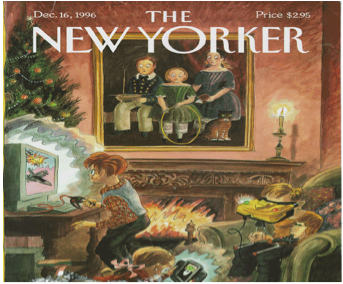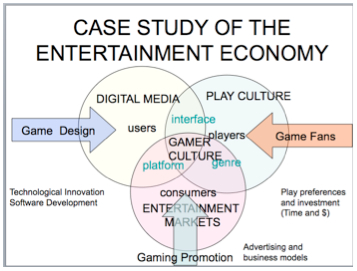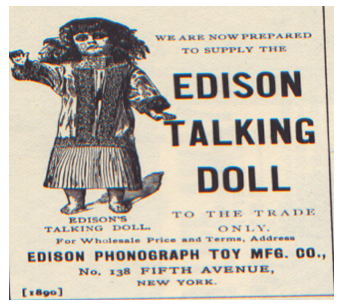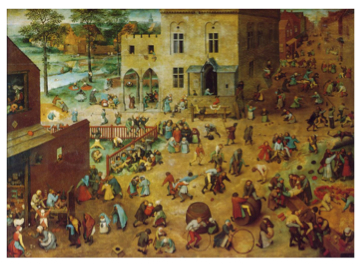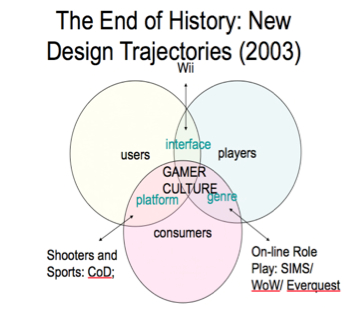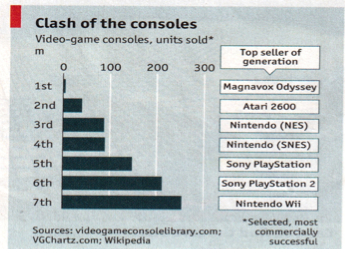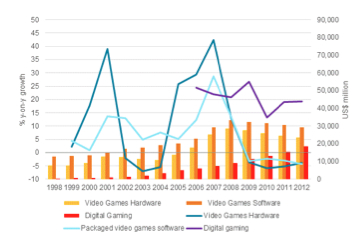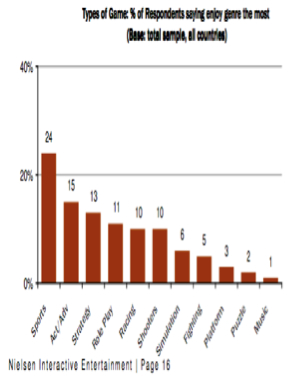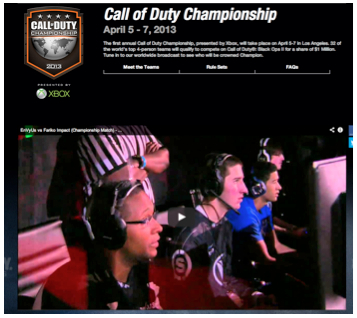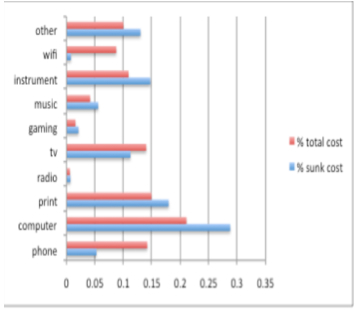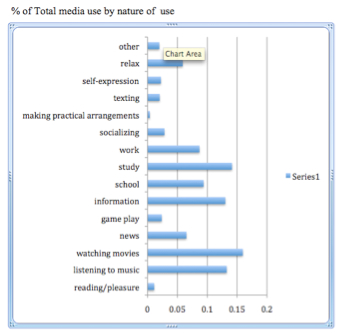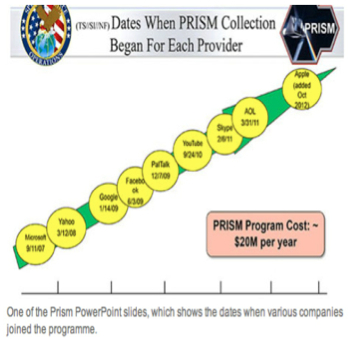Stephen Kline![]()
Simon Fraser University
Section 1: On Writing Video Game History
In his sequel to the hitchhikers guide to the galaxy, Douglas Adams (1980) described the ideal place where media historians can go for a night out on the town. It is called Milliway’s, the Restaurant at the End of the Universe. Here guests travel to the edge of the time-space continuum to enjoy rare and exotic dishes while watching the universe destroyed at the end of history. It is easy to see why this is the preferred dining spot of many historians, for it is here that the Janus gods of historians — Temporality (Chronos) and Necessity (Ananke) – become one. At the end of the universe, all events become inevitable and the problem of an uncertain (and contested) future disappears from the world (like the elves leaving Middle Earth).
Early mass society theorists (mostly following Marx) threatened to turn writing media history into a reductive story about the alienation of mass audiences amid the ever greater exploitation of the working class by corporate capitalism. No doubt a few video game historians would be among the stalwarts who make the pilgrimage to Milliways to view the end of the universe as the triumph of mindless exploitation. One can imagine them downing crab salad as they reflect on the ultimate pointlessness all human inventions and creativity. Perhaps they will debate why Barbie was the most successful game designed for girls, swap tales about where the 5 million Atari 2600 ET video game cartridges were, or even explain why the ill-conceived launch of the Xbox One lead to the beginning of the gaming bust of 2015.
But I would probably not dine among these gaming historians at Milliways: Although these debates are interesting clues to a pivotal moment in human history, at the end of the universe, when history becomes necessity, writing about the dark side of technology becomes a banal form of accounting – a connecting of dots that leads to an inevitable end. Although I regard myself as a critical cultural historian, I had little interest in writing a history of video gaming which amounted to chronicling the road from Barbie to barbarism.
In this I am not alone. Although his writing is now often dismissed as enigmatically inconsistent, for me McLuhan’s Mechanical Bride offered the first glimmer of an alternative way of approaching the study of mass mediated social change. McLuhan’s central argument was that inventions in communication technology had become a driving force in the trajectory of modern capitalism by galvanizing change in the cultural dynamics of industrial society. The challenge presented by the rapid social change of late modern society however was to develop a critical method of cultural historical analysis which could make sense of the cultural maelstrom of market capitalism as an evolving media environment which was restructuring the negotiations between producers and consumers of experiential commodities.
Building on McLuhan’s Understanding Media (1964) much subsequent media history was written as a rejection of economic determinism and critical class analysis. Alvin Toffler, for example, brashly proclaimed the overturning of industrial-capitalism with euphoric celebrations of ‘programmable technologies’ as if computers marked a definitive rupture with the modernist era of mass TV and mass marketing. So as the information age dawned, a ‘new’ rhetoric of digital transformation offered a powerful alternative academic narrative to Marxist prognostication of the end of modern history by simply substituted technological for economic determinism.
This optimistic discourse on computers and social change was quickly picked up by technology marketers. The advertising of personal computers during the 1980s seized on this silicon-coated rhetoric of digital empowerment which equated flexible automation with social liberation. Apple’s famous 1984 ad for example envisioned the liberation of the next generation of citizens arising from the implementation of ‘interactive media’ – that is media that responded to as opposed to dominated human users.
As one Agilent technology ad promised, in the age of computerization, the networked marketplace would become a land of ‘dreams come true’ rather than a level playing field where corporations vied ruthlessly for market share and growth. Thus the technically possible was being transformed into the inevitable.
Sometimes all that separates a dreamer from their dreams is the right set of tools. Agilent technologies “Dreams Made Real”.
Suggesting that children’s embrace of ‘interactive’ play media was the harbinger of progressive social change, Nicholas Negroponte’s Being Digital (1995) sanctified this liberationist futurology with his prediction that a digital generation ‘empowered’ by networked interactivity were about to make the world more flexible, democratic, egalitarian and responsive to human desires and dreams. The modern world’s growing acceptance of computerization of daily experience was now hard-wiring progressive social change into everyday life. In the process, further innovations in computing and imagination were now being envisioned as the twin propellants of progressive social change. So if anyone wanted to understand the future, all one had to do was look at the participatory culture being constructed by video game technologies.
Section 2: Generating the Future of Play
Believing that games express something intrinsic to the lived experience of the society in which they are invented, Roger Caillois wrote “The destiny of cultures can be read in their games – or more precisely in the language they use to discuss their experiences of play” (1961: 35). Although the dream of an ‘electronic medium’ for schooling is in evidence before the 20th Century, the enthusiasts’ academic interest in this ‘new’ medium took shape within the debate about ‘computers in the schools’ in the 1980s. This movement was led by educational theorists like MIT’s Seymour Papert (1984) who argued that computers overturned the very fundamentals of schooling by turning learning into an active rather than passive process. In playing with computers the young were learning to ‘construct knowledge’ for themselves, not accept knowledge from authorities. Based on his work with the Logo turtle, he predicted that in the schools of the future, the drudgery of rote learning was going to be history, and learning was going to be fun.
Increasingly accepted into the curriculum, it was the computer’s inherent ‘interactivity’ that was being identified as the key driver of progressive social change in the Information Age now. Thus growing interest in computer aided learning peaked in the 1980s bathing the promotion of PCs in an aura of playful learning. Marketers of digital technologies, from Intel to Rogers Cable wove the praise of playful learning into their promotional strategies.
“Hot wiring BC kids for a competitive world”
My study of early digital industry advertising during the late 1980s and 1990s documented the emerging discourse on the transformative power of interactive play technologies as a new form of mass entertainment (Kline and de Peuter 2002). Espousing the core ideas of smart play – self-mastery, imagination, agonic sociality and individual freedom – the gaming industry’s own marketing campaigns used the same ideas to consolidate its loyal following for both console and PC gaming – particularly targeting adolescent males with the thematic of militarized masculinity.
You know who lives in the third dimension.
You know who is in control.
You know who has four times the action.
You know who feels the freedom.
You know who breaks the barriers.
You know who stands out from the crowd.
You know who everybody is after.
You know the games of Nintendo 64.
Pointing encouragingly to the fanatical popularity of video gaming among the young, Douglas Rushkoff’s Playing the Future (1997) advised worried parents to support youthful fascination with these interactive playthings whether in the home, schools or the arcades. Young peoples’ obsessive playing of video games was a sure sign that this chaos-wracked generation were appropriating new media in agentive and healthy ways as a preparation for a future mediated marketplace structured around networked access to information.
Their immersion in martial contests and racing was to be welcomed as this generations ‘anticipatory socialization’ into a ‘culture of interactivity’ which eventually would supplant the passive top-down cultural practices consolidated around TV’s mass entertainment.
Towards a Critical History of Digital Playthings
To a media historian, the promise of revolutionizing technology is an old story that we have heard before whether told in the pessimistic or optimistic mode. Telephones, radio and TV have all been hailed as agents of progressive social change. Yet the phone that allows friends to stay in touch across continents also allows telemarketers to disturb the family mealtime in the name of commerce. So too the networked classrooms of the late 1990s enabled cyber-bullying in the dawning millennium. The cell phones that helped organize the Arab spring can also be used to identify and jail the organizers.
In writing Digital Play (2003), we set out to create an alternative account of the rise of gamer culture to that of both the pessimistic economic reading and the celebratory accounts of the future of play culture. The problem we saw with this promotional prognostic of a ‘future perfected’ by the digitalization of playthings was that it had forsaken critical analysis of the interplay of producers and consumers in the global marketplace. Shucked of the language of determinacy, we still found the idea that video gaming provided an opportunity to better understand the broader socio-cultural changes taking place in the Information Age intriguing. Our ambition was to provide a corrective to the digirati’s celebration of video gaming as transformative reversal of the political economy of mass entertainment: we sought a case study that would comprehend not only the rapid expansion of the networked marketplace but also the stock market crash that followed.
Our framework of analysis therefore borrowed heavily from Raymond Williams’ critical analysis of TV programming developed in his book TV: Technology and Cultural Form (1974). Williams argued that the TV medium was not so much invented as developed along a trajectory of technological innovations (of cameras, screens, broadcast aerials etc.) which enabled the mass diffusion of this audio-visual programming after the war. Funding for these developments was made available largely because the programming of early TV attracted a mass audience who tuned into the growing range of broadcasts. Their willingness to watch regularly in turn urged further innovations (in screen resolution, colour, remote control, VCR, digitalisation) depending on proven audience interest. Technological innovation then is part of the story of TVs ascent but not a sufficient or isolated condition.
Williams work shifted media analysts attention to the interplay of technological innovation and cultural creativity in the business strategies that ‘produced the TV consumption’ of audiences. For in the marketplace for entertainment, any new medium must first and foremost produce an audience or fan base that consumes that medium. For the development of TV, as in previous cultural industries, the building of an audience required investment in creative experiments in programming and scheduling of content. In the case of TV, the fledgling industry first borrowed broadly from radio, film, books, stage, concert hall and magazines to create the content, formats and genres that were to establish TV as the pre-eminent domestic entertainment medium. In the commercialized context of North America, only those programme genres that were deemed profitable, or legitimate as was the case of TV news and current affairs, gradually defined the legacy of the domesticated cultural ‘uses’ of this technology. Ultimately markets therefore discipline cultural trajectories. And as Williams noted, in its quest for audiences the industry must understand the entertainment values that attracts those audiences. Audience research therefore is central to the success of any mass medium.
Video Games and the Marketing of Play
Some historians at this conference see the origins of video game studies in the optimistic academic debates arising in the 1980s about the new possibilities of using computers as a learning technology (Espen Aarseth at this conference). The problem with this argument however is that it ignores both the early history of gaming in the arcades and the broader changes taking place in the entertainment industries more generally that have impacted game design. Indeed interactive learning technologies were having a less immediate impact on the schooling, than video games did on children’s leisure time. First in the arcades, and later in the home, the popularity of video gaming consoles grew as Nintendo and Sega promoted interactive play as a domestic mass medium by competing in the entertainment market.
As an historian of toys and games I was well aware of the interplay of technological design and genre innovation in the formation of the playthings industries during the last century. My work on early video gaming design therefore sought to acknowledge the legacy of marketable play forms and play values like sports and puzzle games that inspired these early explorations into the possibilities of computerized play. Historians for example have documented how that early experiments in game programming were based on Chess, Tennis, and Puzzles. As with TV, the content and form of those early arcade games was also built on ideas adapted (some might argue IP stolen) from extant play industries including pinball, shuffle board table hockey and foosball game systems. Their historical importance then is that they demonstrated the possibilities of computers by transposing established game concepts for this screen based programmable technology.
In Digital Play we note that investment for ongoing development of console and computer gaming technologies mounted because of the surprising popularity of these adaptations. Pong, Space Invaders and Pac Man had consolidated the first fan base for this type of entertainment because they were playthings, not learning machines. Even Papert’s Logo turtle was not really a computer but rather a programmable toy robot – except not as sophisticated as some being sold in the market. Home gaming systems only became popular after significant improvements in graphic and interface devices developed in the arcades being transferred to the branded gaming consoles, some of which were marketed by toy makers like Coleco-Vision (who also produced Cabbage Patch Dolls video game). Indeed, revenue from the arcades vastly exceeded those from early gaming consoles or PC game sales. Indeed, video games were classified as part of the toy industry until 1986 by NPD, the leading market research company monitoring this section. Some industry sources continue to report video game sales as part of the playthings market.
The Future of Play through the Rear View Mirror
As an historian of marketing, I have noted in Out of the Garden (1993) that technological inventions have long inspired a growing diversity of play forms and values made available over the last century – whether it be the industrial manufacture of electric trains or the precision forming of plastic Lego blocks after WWII. A genealogy of the video game medium might benefit from looking back to the historical roots of toys, games and sports to understand how computers influenced design and marketing of playthings – and vice versa. Although a history of playthings marketing is beyond the scope of this paper, the valorisation of children’s play as the work of childhood during the late 19th Century resulted in the popularization of urban playgrounds and sports field, as well as toys into the house as evidence of modernization.
I note three subsequent tendencies in the modernising playthings sector which augured the expanding range of play values designed and marketed since the beginning of the 20th Century. Firstly, although mechanical toys like the jumping Jack are very old, there was a growing fascination with technologically enhanced playthings that accompanied modernization such as the speaking doll invented by Edison or the electric train sets developed by Lionel which extended the possibilities of ‘interactivity’ defined as player control over the play action.
The second was the articulation of a marketing rationale for play which linked toys to a child’s cognitive or emotional development. Whether a learning toy for Playskool or a Daisy air rifle, toys were sold as crucial to children’s growth.
The third was the playthings industry’s recognition of the marketplace synergies that existed between playthings marketing and popular culture. Whether a ray gun based on a comic or a guitar with mouse ears, the simulacrum worlds of toys often echoed the imaginary narratives of popular pastimes in the same way that Star Wars, which earned more in toy sales than it did at the box office, influenced Space Invaders.
As I have argued in Out of the Garden, the playthings market boomed (from 2 to 12 billion in the USA alone) during the 1980s, in the wake of Reagan’s deregulation of children’s television advertising. The result was not only growing innovation in playthings design but in the marketing strategies and synergies which could underwrite that growth. The toy industries thus not only became innovators in products (2400 new toys are introduced every year) but in marketing them. The result was not only the profusion of character toys (GI Joe, She-Ra, Jem, Transformers, etc.) that powered this growth but innovations in computerized devices like Speak and Spell and Captain Power. It was into this competitive marketplace that video game consoles were introduced as an innovative plaything – both competing of entertainment dollars and connecting directly with the screen that now became the site of this new form of play. Although this was a moment of great dynamism and creativity in the play market what was less clear was how the play values programmed into these home gaming consoles had reversed the course of mass society.
The Three Circuits Model
Two basic ideas underscored my interest in situating this critical history of video game design in the context of mass entertainment marketing. The first was my interest in understanding the dual character of playthings as both a medium of communication (whose designed affordances reveal implicit messages about their ‘intended’ use in play) and as commodities bought and sold in the market. By inviting children to play, all playthings are designed to open up the players lived experience to imagination, celebration, fun, abandon, and to uncertainty – depending on the designers conception of play. A plaything, whether a doll or a chess board, is therefore specifically programmed (or culturally ‘encoded’) with cues to their manner of use by the player. In this sense whether building blocks, puppets or dominoes, toys are the prototypes of interactive media. Plaything design involves the application of an understanding of play forms and play traditions that must be translated into specific imaginary rules of deployment that a player uses in the activities of playing.
The second was my strong belief in the enduring importance of play itself as a cultural practice. As play’s leading historian Johann Huizinga insisted in Homo Ludens (1954), because it is paradoxical, play liberates the imagination from necessity: And by opposing freedom to act with rules, games and sports confront us with a philosophical dilemma. We can either follow or subvert the rules and expectations encoded into the game or toy: Barbie is designed for girlie fashion play yet dressed in a suit she can also be as president of the world or a ‘honey pot’ spy if the player so chooses. The imaginary bracketing of necessity Huizinga argues, thus pervades the experiences of players. In these momentary delusions of playful possibilities, we discover that our imaginary experiences are not constrained by the laws of history or the cultural messages programmed into the game. Toys and games are therefore the templates of interactive communication media, for despite the meanings encoded in them by the designer, the player is always free to transgress the game or narrative by making meaning for themselves.
The Tyranny of the Algorithm
And perhaps this is where the critical historian of playthings and the play of the historian merge. There is something I occasionally did when I got bored or annoyed while playing a video game in the 1980s. I called it going to the end of play. It started when I first played a badly designed maze game many years ago. Rather than trying to finish the game’s narrative of discovery and conquest, I began to explore sections of the maze that I already knew to be dead ends. Sometimes I would hurl my avatar at the walls of blocked passages not in the hopes of discovering a secret passage, but rather to vent my frustration at the limits of the game’s poor design.
At other times, frustration at trying to change a characters clothes, voice or movements invoked my rage at the ‘invisible hand of the programmer’. In racing games, when bored, I began to purposively drive ‘off road’ to see how far the terrain extended. In fighting games I might try to hide from the enemy or leave the city or battlefield just to see what there is at the farthest edge of the imagination of the games design team. The end of the game varied — a wall, a row of hills, an empty desert or a Klein bottle topography that endlessly folded in on itself – it didn’t matter. But exploring the game’s limitations became more interesting for me, than playing by the rules, for in this moment of playful transgression, I stopped playing in the game as designed, and started playing against the game ‘s designers. At the end of play one confronts the game maker by realizing the design constraints of the games algorithm.
In a recent Coke advertisement an avatar is shown on a casual stroll through a city transgressing the ruthless anti-social morality programmed into GTA, by turning every encounter into a humanly positive narrative.
So too, the interactive artist Jim Munroe transgresses the design of GTA by searching out a quiet place of contemplation within the urban game – such as going to a quiet alley or roof-top of a tenement to construct an interpretive deviation within the agonic contest of the game. As a critical strategy, these whimsical deviations echo the ‘situationists’ theory of the ‘urban dérive’ transposed into the virtual universe. Undertaking the derive the ‘artist’ sets out to experience the ‘urban gaming space’ as an abstraction – an algorithm – by deviating from the invisible constraints on experience in order to open the game to personal re-interpretation. Confronting the algorithm is meant to remind us that video games, like real cities, are designed spaces which are paradoxically forgiving of playful transgression even while they narrow the possibilities of consumer choice.
My own ‘off-roading’ therefore was closer to Guy Debord’s notion of a theoretical ‘détournement’ than the situationist ‘dérive’. As Debord (1956) states, the purpose of historical criticism is to restore “subversive qualities” to accepted historical truths by seeking a conceptual detachment from the instruments that shape our experiences in any historical period. As a gamer, détournement implied unmasking the algorithm controlling my play experiences. But as a historian I knew that the algorithm does not just refer to the programmers code for guiding game action – but to the historically constituted and institutionally constrained way of thinking about the ‘possibilities of play’ that are written into the market. This meant reflecting on the ways that the game industry controls my play experience, not only by constraining the chips, interfaces, goals, the rules, the aesthetics, the genres, the playability, the financing, the marketing strategies advertising and the labour within gaming industry. To reclaim my freedom as a critical player-historian then, I must subvert the game industry’s attempts to reduce the infinite possibilities of game play to the manageable probabilities of in-game experiences marketed in the expanding entertainment economy.
Our historical analysis applied Williams’ critical perspective to the formation of this new entertainment medium by focusing on three domains of cultural practice in the video gaming industry – the hardware and software design (technological invention), the promotional discourses and business models that guided the market expansion (marketing strategy), and the construction of gamers as an audience including their identities, play practices and preferences (playability). Dubbed the three circuits model, this framework was developed as a temporal map to guide our critical exploration of the interplay between technological innovation and changing play practices in the digitalizing marketplace. All historical writing involves curatorial choices. The model therefore oriented us to the intersection of these semi-autonomous vectors of development: 1) the interplay of technological innovation and marketing (i.e. an emphasis on branded console marketing and perpetual upgrade business models); 2) the interplay of technological design and playability (i.e. interface design, 3D graphics and sound, joysticks); and 3) the interplay of game fans and marketing strategies (i.e. blockbuster game sequels; in game advertising; on-line communities).
Section 3: Meditation on the Ends of (Writing) History
By emphasizing the markets changing relationship between producers and consumers of gaming technologies, our historical media analysis sought to explain the growing popularity of interactive playthings in the late 21st century. Its focus was on the role that innovations in hard and soft technology, game design and marketing played in making game play as a popular cultural practice. We have argued that continual upgrades to hardware and software (chips, 3-D graphics, control devices, networking) were fundamental in fostering the industries cycles of expansion.
So too creative game designers were crucial in translating popular play forms and genres into networked and console gaming blockbusters (shooters, racing, puzzle games, MMOGs). And most importantly we argued that innovative marketing practices beyond standard branded advertising and promotional techniques (in game advertising, on-line subscriptions, promotional synergies within popular culture) were crucial in establishing gaming as a 30 billion dollar a year business in the networked ‘entertainment economy’.
But our history ended in 2003. So did our understanding of the dynamic interplay between game makers and game players in the cultural marketplace provide a useful understanding of the future of the experience economy – and its promises of growth, democracy and personal freedom? Ten years on I can say ‘yes’ and ‘no’.
On the yes side we can argue that not much has changed over the last 10 years. Although estimates for 2013 vary, anywhere from 40 billion to 100 billion, a reliable source estimates total global sales of $67 billion in 2012 suggesting that the sector has continued to grow much faster than other sectors of the cultural economy – whether films, music or newspapers (data mostly from VG Chartz). This growth is a sign that game designers have maintained their connection with the youthful fans it first attracted – even as they aged, while attracting some younger ones to the fold. Their innovative business models have successfully identified and upgraded the play preferences of their hard core fan base.
I think it is fair to say then that the video gaming industry continues to be based on console branding and online subscriptions of the competitive business models that it developed for selling game blockbusters in the networked world at the beginning of the millennium.
•Hardware/ Consoles
•Game Software
•Subscriptions
•Licensing and Synergies
•In game advertising
•In game markets
It is true that the average hard core gamer is no longer a spotty teenager, although in many cases these gamers are still playing upgrades of some of the same games they played back then. Based on the genre sales figures, I think it is also reasonable to say that rather than innovation in game design, that sports, shooters, racing games still top the charts much as they did in 2003.
Despite the waning interest in some of the games (Sims online), and perhaps the Nintendo Wii and its willingness to design a line of games which take advantage of its novel interfaces, not much has changed.
Although thematically innovative adaptations are being developed at the fringe of game design by independents still following pop culture fads (vampires and zombies) most of the game design independents survive through serialization of their most successful games – GTA, FIFA world cup, Call of Duty, Warcraft, Mario, Halo, etc.
Of the criticisms of this industry then, the oligopolistic structure, masculine ethos and narrow play values of oligopolistic gaming enclaves formed around the Xbox, Nintendo, Sony and PC-Online tribes, which has made gaming in a mass spectacle of agonic play, is as valid today as it was in 2003.
On the no side, one finds however signs that as the industry grew more cumbersome its lack of ‘innovation’ has taken a toll on its creativity. Although early video game designers showed a willingness to explore the playful possibilities of new technology, it is now apparent that maintaining the pace of technological innovation is extremely difficult in oligopolistic markets, largely for economic reasons of risk. Over the last five years, without major upgrades to the core gaming technologies, industry revenues have dropped by about 12%.
More importantly the balance between shares of income from hardware vs. software sales has changed considerably from 58 to 38%. And as in other sectors, in game advertising revenues and on-line subscriptions are static even while on-line competition is mounting from corporations using ‘advergaming’ as a promotional strategy.
My own recent tracking of the time and money expenditures on communication by my 18-25 year old students reveals interesting trends that suggest they spend less time on console gaming and more money on smart phones and home entertainment TV.
These studies do not suggest an end to gaming but rather a major shift in the types of technology that people are gaming on – the hand held devices and phones which are amenable to multi-tasked media use that is common among these university aged respondents, also suggests a psychological engagement in gaming different from the immersive and attention riveting experiences of console and on-line shooters that were the preferred entertainment of the heavy games 10 years ago. Which is why the industry is currently in turmoil: its hard core audience is aging while its recruits are pre-occupied by Facebook and Angry Birds.
The troubled political economy of the perpetual upgrade economy was illustrated in the ongoing console launch wars at the recent E3 trade show where the strategies for the next generation of gaming consoles were revealed (The Economist, May 25, 2013). But all these latest gaming innovations are caught between their commitments to their biggest fans and a desire to be the living room hub for the on-line war in a changing entertainment market. And it seems that while the pace of innovation has slowed in the console and gaming industries it has accelerated in the on-line advertising and smart phone industries which are based on different business models but target the same consumer. In addition to a growing interest in advergaming, the commercialized world of on-line entertainment is monetized by renting data access time (cable and phone companies), downloading of apps and the pin-point target advertising based on searches and click throughs.
•Search Word Revenue
•Click Through Revenue
•Selling Consumer Data to Advertisers
•Advergaming
•Mobile Location
But the gaming industry remains wary of the hackable on line world, perhaps because it has not figured out to benefit from these new business models and struggles to find a way of stemming the illicit trade on games which has been estimated as approaching 3 billion dollars in value.
In this respect I am reminded that video gaming has roots in the playful transgressions of the hacking, cracking and game modding circles which it helped to cultivate. Back in the day, I can remember my Amiga software cracking programme opening by singing “yo ho, yo ho, it’s a pirate’s life for me”. This subversiveness that playful transgression of the gaming market brings to on line entertainment a savvy kind of player who is able and willing to game the mass entertainment system by refusing to pay for the commodity. This is not only a loss of revenue to the industry, but also indicates a gamer attitude that is hostile to overt attempts at market manipulation and direct advertising necessary to monetize gamer culture.
Which is why it was across the street from E3 2013 that a self-proclaimed hacker player company in the console market had set up shop launching its open source Ouya console in an attempt to compete with the Xbox One and the Sony PlayStation 4 with downloadable and mod-able game apps on a price point basis. This attempt to disrupt the big boys of gaming is predicated on a new market algorithm developed outside of gaming industry – cloud computing, open source, hackability.
Ironically, what the open source cloud based gaming apps that developers are producing however are games that look a lot like the games people were playing back in 1995 when I first turned my attention to the gaming industry as a new mass medium. They lack that ‘immersive interactivity’ that the console industry strove to cultivate. They can be played on my Android phone as easily as in my enhanced screen living room entertainment system. Which reminds me of a very important point raised by McLuhan: a new medium is not just a commodity sold in the marketplace, but a disturbance of the cultural environment.
I thought of this hacker culture argument when I examined Snowden’s recently released evidence about online surveillance. Companies like Google, Apple, Facebook, Skype, etc., were all having their meta-data tapped by the NSA. But online gaming companies were noticeably absent.
Reflecting on why this was the case I realized that what was missing in the on-line gaming e-business model was the exploitation of audience information. While Google, Facebook, Yahoo and Apple all developed ways of monetizing the time spent online searching for information, entertainment and friendship, the video game industries remained on the sidelines, fearing no doubt alienating gamers if they saturated game space with marketing and demanded demographic data from users. The growth of advertising on-line represents the triumph of this new business model of selling consumers rather than play experiences. And what are lost in this commercialization of ‘networked media’ are both our privacy and our freedom. It occurred to me that this made private on-line game meetings not only a relatively safe place for plotting illicit events but a real alternative to the 1984ish perpetual surveillance e-conomy.
And so I find at the end of this historical overview a circular irony: the on-line entertainment economy that gaming helped to consolidate as part of a military strategy to reduce the risk of nuclear strikes, has now become a commercial space where hacking and surveillance have become the military strategies of choice. It is also a cyber-world where businesses in the entertainment economy possess more information about us as consumers than governments do of us as potential criminals. Except when we play.
References
Douglas Adams, Restaurant at the End of the Universe. Pan Books, London, 1980. Print.
Marshall McLuhan, The Mechanical Bride: The Folklore of Industrial Man, Vanguard Press, NY, 1951. Print.
Marshall McLuhan, Understanding Media: The Extensions of Man. Cambridge, MA: MIT Press, 1964. Print.
Nicholas Negroponte, Being Digital, Vintage Books, NY, 1995. Print.
Seymour Papert, Mindstorms: Children, Computers and Powerful Ideas, MIT Press, Cambridge Mass., 1984. Print.
Roger Caillois, Man Play and Games, English Translation, The Free Press, NY, 1961. Print.
Stephen Kline Out of the Garden, TV toys and play in the age of marketing Verso: London, 1993. Print.
Johann, Huizinga, Homo Ludens. A study of the play element in culture. Routledge and Kegan Paul, 1954. Print.
Guy Debord and Gil Wolman. Users Guide to Detournement 1956. Web. http://www.cddc.vt.edu/sionline/presitu/usersguide.html
Stephen Kline, Greig de Peuter and Nick Dyer Witherford. Digital Play, McGill-Queens, Montreal, 2003. Print.
Raymond Williams TV: Technology and Cultural Form, Fontana, London, 1974. Print.
Stephen Kline and Greig de Peuter. “Ghosts in the Machine: Video Game Culture” in Dan Cook, Symbolic Childhood, New York: Peter Lang, 2002. Print.
Douglas Rushkoff, Playing the Future: How Kids’ Culture Can Teach Us to Thrive in an Age of Chaos, HarperCollins, Canada, 1997. Print.




